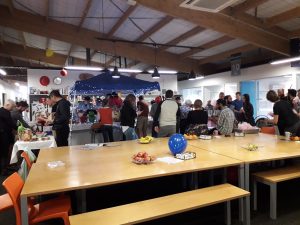

From businesses doing good to charities running businesses and everything in between, social enterprise as an industry is growing up and holding its first national conference.
In 1942 the New Zealand poet Allen Curnow wrote: “Simply by sailing in a new direction, you could enlarge the world.” He was talking about the first European explorers arriving in New Zealand on their wooden ships but his statement could also apply to the expanding social enterprise movement in New Zealand.
The movement is actively pushing boundaries in the pursuit of a combination of both profit and purpose. It involves re-imagining the future of business as a means to provide incomes for employees and generate profit for owners, while also addressing social or environmental needs. In short, the organisation acts ‘for purpose’.
So where are we on the social enterprise journey in New Zealand? Is it even right to start describing this as a sector, and where does social enterprise fit in the spectrum between charity on the one side and entrepreneurial upstarts on the other? My view is that social enterprise is now charting into new territory and enlarging our understanding of the world, and that is shown by a few indicators on our map.
First, the sure sign of legitimacy for a group is a national conference devoted to gathering like-minded people together. A year ago in Christchurch the Social Enterprise World Forum was held with more than 1,600 attending. A global event held in this country was perhaps an unusual mountaintop, but it certainly kick-started a lot of discussions and planted many seeds for those who attended.
But the truest signal that social enterprise as a sector has really landed here is happening this Friday, when Wellington Zoo plays host to the Ākina-organised Aotearoa Social Enterprise Forum. The day-long event will feature an overview of the scene in New Zealand as well as 14 sessions on topics such as
- measuring impact
- Māori and indigenous enterprise
- social procurement
- youth and social enterprise
- legal structures for social enterprises
- activating impact investment
- environmental accountability
These topics show that those involved are thinking more deeply about the real impact and implications of starting a social enterprise. They are important issues for those involved in starting or running social enterprises, although some cautions and questions I wrote about here almost a year ago still apply. The credibility of the sector will depend on social entrepreneurs having some good answers.
I’ve certainly noticed an elevation in the thinking among the 65 guests interviewed for my podcast, seeds, which focuses on social entrepreneurs. The depth of understanding about the basics of social enterprise we are seeing now has been revealing. It’s like we really are sailing in the new direction that Allen Curnow talked about, which is opening up new horizons for the possibilities of social enterprise.
Additional evidence of this local growth in social enterprise is the fact that the term itself is becoming more widely known, discussed and – most importantly – understood. That wasn’t the case even a year ago. You can also see changes in how each end of the charity/business axis is approaching social enterprise principles. For example, an increasing number of entrepreneurs are incorporating social enterprise into their standard business models. It’s clear that younger generations do this more naturally than previous ones, who were more likely infected by the “greed is good” mantra of movies like Wall Street.
A diverse range of start-ups are demonstrating this. Check out the stories of 27 Seconds, a social enterprise winery where profits go towards reducing modern day slavery (more on Alanna Chapman and their journey here), Crave Café in Morningside (Nigel Cottle’s story is here and earlier in Spinoff here), or Digital Journey which provides free resources for companies to check their internet presence and promotes better use of technology (hear Stuart Dillon-Roberts’ story here).
But what about corporates? They’re getting in on the act too. NZ Post recently introduced a new “Social Procurement” strategy as a way for it to interact and engage meaningfully with social enterprises. Earlier this year it won the Sustainability Project of the Year award at the New Zealand Procurement Excellence Awards for its efforts in this area. There are many other private, public and not-for-profit entities also interested in pursuing a social procurement approach in New Zealand. It’s an encouraging trend: a large customer base that social enterprises can sell their goods and services to will be vital for their long term success.
Over in the ‘traditional’ not-for-profit world, many charities are realising that grant funding can only go so far, and they are exploring other ways (including setting up businesses) to achieve their charitable purposes. An example is Pathway, a charitable trust that helps prisoners reintegrate into society. Pathway has two companies which operate for profit while also providing employment for the very group the trust is focused on. Other examples of larger charities operating businesses areTrade Aid and Kilmarnock , both of which provide employment opportunities for those with disabilities (hear an interview with Kilmarnock CEO Michelle Sharp here and read more here).
It would be remiss not to mention the other big growth area, impact investing. Social enterprises need funding to start and grow. New Zealand now boasts its own impact investing network and earlier this month it was announced that the Impact Investing National Advisory Board of Aotearoa New Zealand has become a member of the Global Steering Group for Impact Investing. A real-life example of this trend here is the Impact Enterprise Fund that had a first close of an impressive NZ$8 million. Impact Ventures’ Chris Simcock is currently working on finding investment opportunities for that fund and he explained how this whole area is evolving in New Zealand when I spoke to himrecently. Another local example is the work of Soul Capital which invests in social enterprises.
Lastly, it is heartening to see that business in general is becoming more aware of social enterprise concepts; it may be that more organisations will self-identify as social enterprises in the near future. Research is currently being undertaken on whether options including new legal structures to empower social entrepreneurs would help the sector grow. Enabling organisations (whatever their legal form) to act with purpose and helping them articulate, clearly communicate and report on their purpose will become increasingly vital. There is also a growing realisation of how important it is that the work of social enterprises not become isolated as something “they do”. Instead the ethos behind the movement must be encouraged to permeate the mainstream business world as well.
It really is an exciting time to be involved with social enterprises as we further expand the boundaries and explore what it means in the New Zealand context – for example, what businessescan learn from Māoritanga that is unique and distinctive.
It will be fascinating to watch what emerges from the hui this week in Wellington as more connections are made among those who attend. The social enterprise sector is here to stay. I hope those on the journey will continue to sail in new directions and in doing so the world will keep enlarging as we push out further and discover more about the power of doing business that also does good.
Steven Moe is a lawyer and the host of the seeds podcast, which features interviews with social entrepreneurs. He is the author of Social Enterprises in NZ: a legal handbook, available for free by email: stevenmoe@parryfield.com.
The Spinoff’s business section is enabled by our friends at Kiwibank. Kiwibank backs small




























